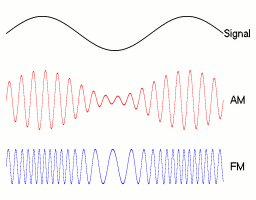Define Angle or Phase Modulation:
“Angle modulation is a non-linear process and transmission bandwidth is usually much greater than twice the message bandwidth. Because of larger bandwidth, this modulation provides increased signal to noise ratio without increased transmitted power.”
Basically, angle modulation is divided into two categories namely Frequency Modulation & Phase Modulation.
One significant characteristic of this type is that it can better classify in contrast to noise and interference signal than amplitude modulation. This adjustment in execution is accomplished in the expense of expanded transmission bandwidth; that is, this modulation gives us a method for improved signal to noise ratio.
Besides, this improvement in execution in angle modulation is achieved in the expense of complex circuitry in both the transmitter and receiver section and not possible in Amplitude one.
Mathematical Expression of Angle Modulation:
Let θi(t) signify the angle of a modulated sinusoidal carrier at time t; it is assumed to be a function of the information-bearing signal or message signal. The resultant angle-modulated signal is,
s(t) = Ac cos [θi(t)]
Where Ac is the carrier amplitude, a complete oscillation happens each and every time the angle θi (t) will changed by the value of 2π radians if θi (t) increases with time, then the average freq in hertz, over a trivial intervals of t to t+∆t.
The angle-modulated signal s(t) as a rotating phasor of length Ac and angle θi (t) respectively. Such a phasor’s angular velocity is dθi (t)/dt, measured in radians/sec. The angle θi (t) is represented for an unmodulated carrier signal,
θi (t) = 2πfct + kp m(t)
and the corresponding phasor rotating with a constant angular velocity measured in radians/sec. This constant specify the angle of the unmodulated carrier during that period.
There are various methods in which the angle θi (t) could be changed in a manner w.r.t to the message signal.
Diagram of different waveforms of angle modulation:

Frequency Modulation:
“Frequency Modulation is one form of angle modulation in that instantaneous freq of the carrier is changed proportionally with the instantaneous amplitude variation of the modulating signal”.
FM is one sort of angle modulation in with fi (t) is linearly proportional with the message signal m(t) as expressed below,
fi (t) = fc + kf m(t)
The steady value of fc presented to the frequency of the unmodulated carriers signal; the fixed kf termed as modulator’s ‘frequency-sensitivity factor’, measured in hertz per volt on the other hand m(t) is a voltage signal waveform. Integrating w.r.t time and multiply the result by a factor 2π, we can write

where the 2nd term for the increase or decrease in the instant phase θi(t) due to the message m(t) one. The frequency-modulated signal is consequently,

Phase Modulation:
Phase Modulation is such type of angle modulation in which the instantaneous angle θi(t) is linearly proportional with the message ‘ m(t)’ signal as presented by means of,
θi(t) = 2πfct + kp m(t)
The term 2πfct expresses to the un-modulated carrier angle Øc set to ‘0’ in the phase modulation. The fixed kp value phase sensitivity factor of the modulator, communicated in radians/volt and m(t) is the voltage signal. In the phase modulation, modulated signal s(t) is correspondingly depicted in the time-space by,
s(t) = Ac cos [2πfct + kp m(t)]
Show that FM and PM are basically same:
Let the carrier signal is = Ac cos (2πfct)
Let the message signal is = m(t)
So, the expression of F.M. signal is =

Now if the modulation method is Phase Modulation. then the expression of Phase Modulation signal is
= Acos [2πfct + mp . m(t)]
Where, mp is a constant for the Phase Modulation
Also the Phase Modulation signal can be treated as a Frequency Modulation signal where message signal is dm(t)/dt.
So, basically Frequency Modulation and Phase Modulation are basically same.
Pre-Emphasis and De-Emphasis in FM:
A random undesired signal or noise constantly comes with a triangular spectral distribution in a Frequency Modulation technique, together with the impact that noise happens at the maximum frequency of baseband.
This may be offset, to some restricted selection, by raising the frequencies prior to transmitting and decreasing them with a corresponding receiver number. If we decrease the high frequencies from the receiver, then, in addition, it reduces the high-frequency noise.
These practice of increasing and decreasing of these frequencies are called pre-emphasis and de-emphasis, respectively. Most frequently 50 µs time constant is employed.
The total quantity of pre-emphasis which may be implemented is restricted by the simple fact that lots of kinds of modern sound signal comprise higher frequency energy compared to the musical styles that have predominated at the beginning of FM broadcasting.
They cannot be pre-emphasized since it might cause excess deviation. (systems more contemporary compared to FM broadcasting often utilize either programmed-dependent variable pre-emphasis.)
What is Narrow Band FM (NBFM) and Wide Band FM (WBFM ?
The expression for the FM signals is given by

and hence the instantaneous frequency ωi is given by,

where, kf = constant of proportionality and kr . em (t) represents the deviation of carrier frequency from the quiescent value ωc. Constant Kf hence controls the frequency deviation. If the Kf is small the frequency deviation is also small and the spectrum of the FM signal is having a narrow band. On the other hand, for higher value of kf, we get wide frequency spectrum corresponding to wideband FM case.
NARROW BAND FM:
The modulation index for narrow band FM is generally near unity and hence for this case, the maximum deviation δ<<fm and the bandwidth is
B = 2fm.
This bandwidth is same as that occupied by AM signal. The narrowband FM is used wherein intelligible signals for communications are to be transmitted such as in mobile communication used by police, ambulance etc.
WIDE BAND FM:
The modulation index for wideband FM is greater than unity. The bandwidth of a wideband FM system is given by,
B = 2(δ+fm)
For wideband FM δ<<fm and hence B = 2δ
Thus, the bandwidth of wideband FM is twice the maximum frequency deviation. The wideband FM is used where the purpose is to transmit high fidelity signals such as in FM broadcasting and TV sound.
For more Modulation And Demodulation related article click here

Hi, I am Soumali Bhattacharya. I have done Master’s in Electronics.
I am currently invested in the field of Electronics and communication.
My articles are focused on the major areas of core electronics in a very simple yet informative approach.
I am a vivid learner and try to keep myself updated with all the latest technologies in the field of Electronics domains.
Let’s connect through LinkedIn –